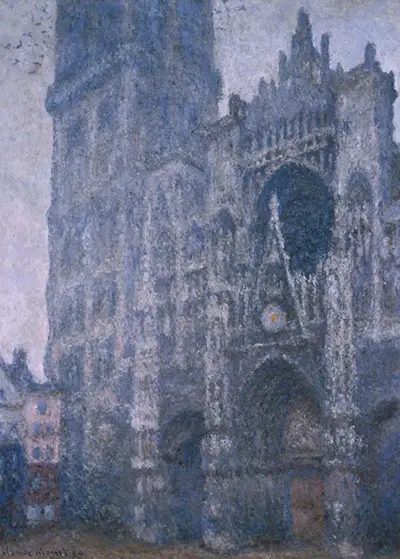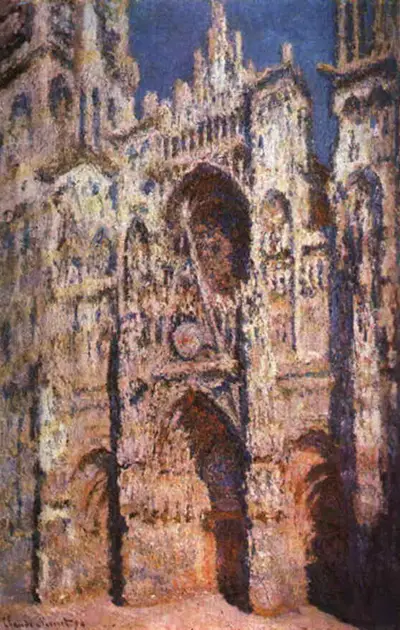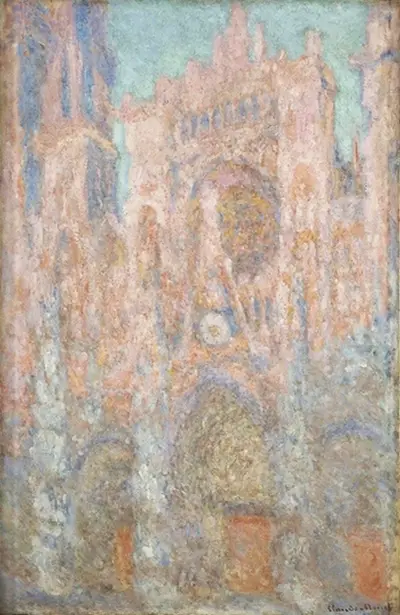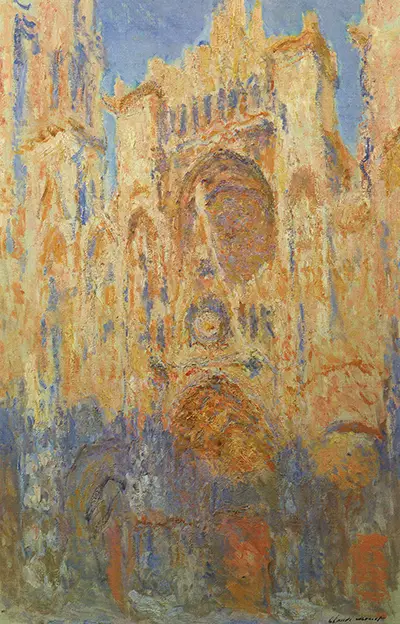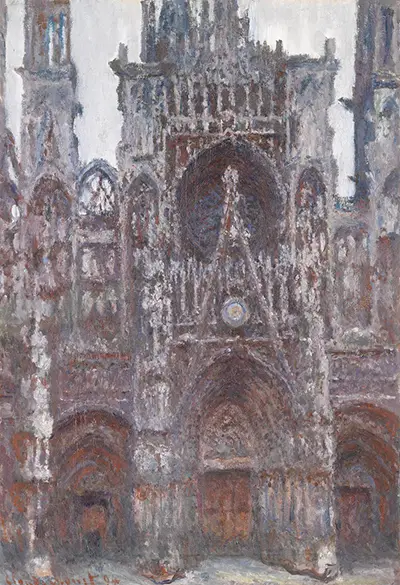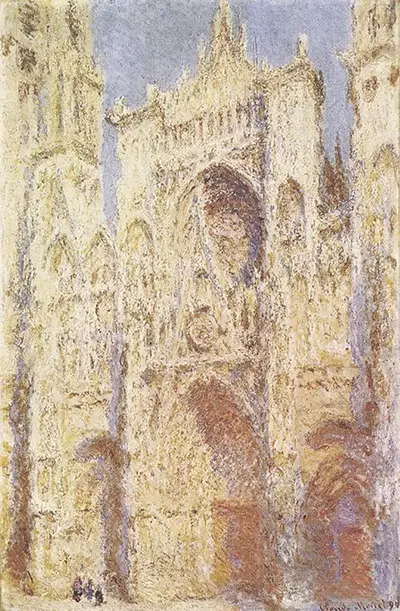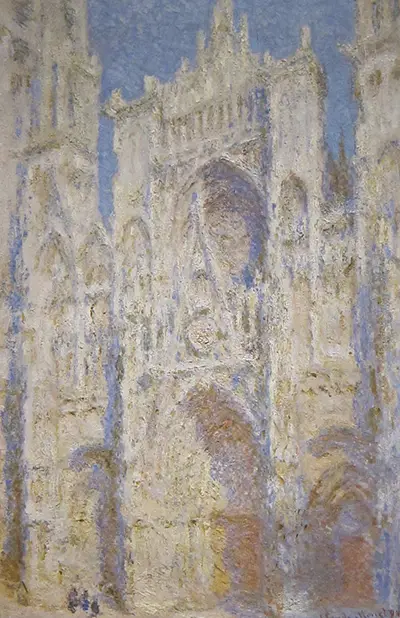"A landscape does not exist in its own right since its appearance changes at every moment but the surrounding atmosphere brings it to life, the light and air which vary continually for me it's only the surrounding atmosphere which gives subject their true value." these words were said by the french impressionist Claude Monet who is the great man behind the famous Rouen Cathedral. The artist rented a room at Rouen above a shop where he stayed for many months and from the ever open window, he painted the cathedral in its various aspects in several pictures according to the time of the day and weather.
He formulated a style in which he rejected the old idea that the shadow of an object was made up from the colour of the object with some black or brown added. The shadows of the art were tinted with complementary colours to give them more vitality with Paint applied in thick brush strokes of pure unmixed colours which blend in the eye of the viewer.
The colours were mixed with white rather than using them straight from the tube to achieve the sunlight luminous effect. The art has a heavy surface quality but evenly textured patterns of brushstrokes suggesting the natural texture of the withered sandstone.
Monet often painted the same scene of the Rouen Cathedral under a different lighting and atmospheric conditions for interest in the effect of lights on its subject, as he also did for his Haystacks series. He used a style of impressionist that attempted a more scientific and analytical approach to the use of colour in art. Using a cathedral as his subject allowed Monet to illustrate the paradox between a relatively solid, permanent stone structure and the evanescent light which controls our perception of it. In these compositions, he used thick impastoed layers of paint, expressive of the nature of the subject.
This texture and Monet's subtle interplay of colours helped to fashion a series of shimmering images that are entirely worthy of their monumental subject. Monet found that the thing he had set out to paint–light–was, because of its ever-changing nature and its extreme subtlety, an almost impossible thing to capture. He was assisted, however, by his ability to capture the essence of a scene quickly, then finish it later using a sketch combined with his memory of the scene.
For the Rouen Cathedral paintings, he used thick layers of richly textured paint, expressive of the intricate nature of the subject. Monet's sensitivity to the natural effects he observed are just one factor that makes these pictures so remarkable; the way he manipulates his medium contributes to their majesty as well. For the surfaces of these canvases are literally encrusted with paint that Monet built up layer upon layer like the masonry of the façade itself. See also the work on architectural paintings by John Singer Sargent. The subtle interweaving of colours, the keen perception of the artist and the use of texture all serve to create a series of shimmering images in light and color–masterpieces worthy of the grandeur of their subject matter.
Evidently, among the canvases of the Rouen Cathedral series, there are more differences than those caused by the different conditions of light and atmosphere. Monet chose five different points of view - two from the square and three from different rooms in the building in front of the Cathedral- representing the Cathedral's portal (frontally or with the point of view slightly displaced to the right), or the portal and the d'Albane tower (to the left of the portal), but always conserving that unusually nearby point of view. 25 of these views are dated 1894, another one is dated 1893, and five are signed but not dated. However, as Monet finished most of the paintings in his workshop, it is more important the date in which each canvas was started (mostly 1892 and 1893). The election of the palette reflects the different shades in which the daily light was dying the Cathedral facade: from the smooth blues of the morning to the vivid ochre and golden shades in the soil pictures, and browns and greys in the cloudy days.
Extending the building's encrusted stone surface to the richly varied impasto surface of his painting, he portrayed the cathedral perpetually re-emerging in the suffused light of early morning.Monet created several groups of paintings exploring the colour, light, and form of a single subject at various times of day, but his Rouen Cathedral series was his most intense effort on a single site. He painted there in late winter in both 1892 and 1893, then reworked his thirty canvases from memory in the studio through 1894. He began this example in 1893, working in an improvised studio in the front room of a dressmaker's shop across from the cathedral. After creating a coherent ensemble, Monet selected twenty paintings that he considered "complete" and "perfect," including this one, for an exhibition at his Paris dealer's gallery in May 1895.
Pissarro and Cézanne visited and praised the series, and patrons quickly purchased eight paintings from the group. Monet's early work is indebted to the Realists' interests in depicting contemporary subject matter, without idealisation, and in painting outdoors in order to capture the fleeting qualities of nature. In his later years, Monet also became increasingly sensitive to the decorative qualities of colour and form. He began to apply paint in smaller strokes, building it up in broad fields of colour, and exploring the possibilities of a decorative paint surface of harmonies and contrasts of colour. The effects that he achieved, particularly in the series paintings of the 1890s, represent a remarkable advance towards abstraction and towards a modern painting focused purely on surface effects.
An inspiration and a leader among the Impressionist, he was crucial in attracting Pierre-Auguste Renoir, Alfred Sisley, Edouard Manet and Camille Pissarro to work alongside each other in and around Paris. He was also important in establishing the exhibition society that would showcase the group's work between 1874 and 1886. Painting the Rouen Cathedral also was a challenge to Monet. Let's imagine the situation: Claude Monet installed next to the window of a second floor in front of the Cathedral, working frenetically with tens of canvases, at the mercy of that a fleeting cloud, an unexpected sun ray or an early morning fog forced him to look for a picture in which the new atmospheric conditions could be reflected.
Of course, such task had to be exasperating, and the painter was on the verge of giving up the series. But Monet was not a man who easily surrendered.As always, the pictures gave him intense difficulties, which threw him into despair. He had vivid nightmares of the cathedral in various colours – pink, blue and yellow – falling upon him. Monet was even forced to finish several canvases of the Cathedral in his own workshop, entrusting the success of the series to his wonderful visual memory. Despite these challenges, twenty of the Rouen Cathedral series were released to the gallery for exhibition and they received a ready market since it was in the 1890s that there was a revival of interest in catholicism. Rouen Cathedral was also among the best gothic cathedrals.
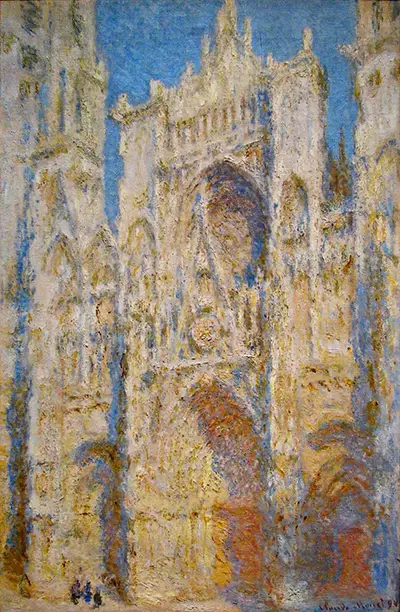
 Claude Monet.jpg)
 Claude Monet.jpg)
 White Harmony Claude Monet.jpg)
 Claude Monet.jpg)
 Claude Monet.jpg)
 Harmony in Blue Claude Monet.jpg)
 1892-1894 Claude Monet.jpg)
 1894 Claude Monet.jpg)
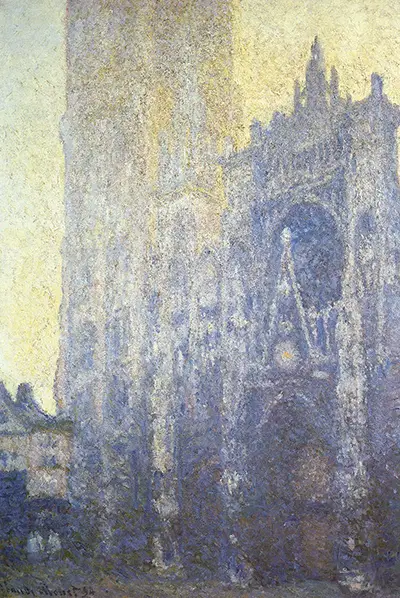
 Claude Monet.jpg)

